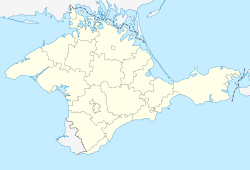SS-N-3 Shaddock
| Utjos (Utes , Sotka , Object 100) | |
|---|---|
| Утёс ( объект 100 , Сотка ) | |
| Sevastopol Balaklava, Russia (de facto) | |
| Coordinates | 44°27′05″N 33°39′09″E / 44.451389°N 33.6525°E |
| Type | coastal bunker AShM missile launchers |
| Site information | |
| Owner |
|
| Operator | BRaV CmF ВМФ ЧмФ БРВ (Black Sea Fleet Coastal Missile Forces) VMF |
| Controlled by |
|
| Open to the public |
no |
| Condition | operational (to be re-operational probably , poxible) |
| Site history | |
| Built | 1950 ? , 60' - 80' |
| Built by |
|
The P-5 "Pyatyorka" (Russian: П-5 «Пятёрка»; "Pyatyorka", "fiver" in English), also known by the NATO codename SS-N-3C Shaddock, was a Cold War era turbojet-powered cruise missile of the Soviet Union, designed by the Chelomey design bureau. The missile entered service in 1959. Pyatyorka is a common name for the missile as the "digit 5", corresponding to the R-7 Semyorka, the digit 7.
The basic version of the missile was an inertially-guided submarine-launched cruise missile to threaten the US coast. The missile could be armed with either a 1000 kg high explosive or a 200 or 350 kt nuclear warhead. It had a speed of about 0.9 Mach, range of 500 km and CEP of about 3000 m. The later variant had a range of possibly up to 1000 km. The first missiles were installed in Project 644, Whiskey Twin Cylinder and Project 665, Whiskey Long Bin submarines.
Versions of P-5 were later developed equipped with radar homing to be used as anti-ship missiles. The last anti-ship versions were retired from active service about 1990, replaced by the P-500 Bazalt and P-700 Granit.
There were actually three versions of turbojet-powered, cruise missiles that were called "SS-N-3" by Western intelligence sources, with multiple variants. The earliest, P-5 was called SS-N-3c, and later versions SS-N-3a and SS-N-3b. The various Russian designations are believed to be P-5 "Pyatyorka", P-6, P-7, and P-35 Progress. Some sources indicate that missiles 'P-10' and 'P-25' may also have existed.
NATO called the submarine-launched radar-homing versions of the P-6 SS-N-3A 'Shaddock'. These were carried by Echo II- and Juliett-class submarines for targeting US aircraft carriers. The Echo I-class submarines were incapable of accommodating the targeting radar for the anti-ship version, and were not equipped with missiles after the land-attack variant was withdrawn, probably in the mid-1960s when sufficient nuclear-powered ballistic missile submarines (SSBNs) became available.
...
Wikipedia

